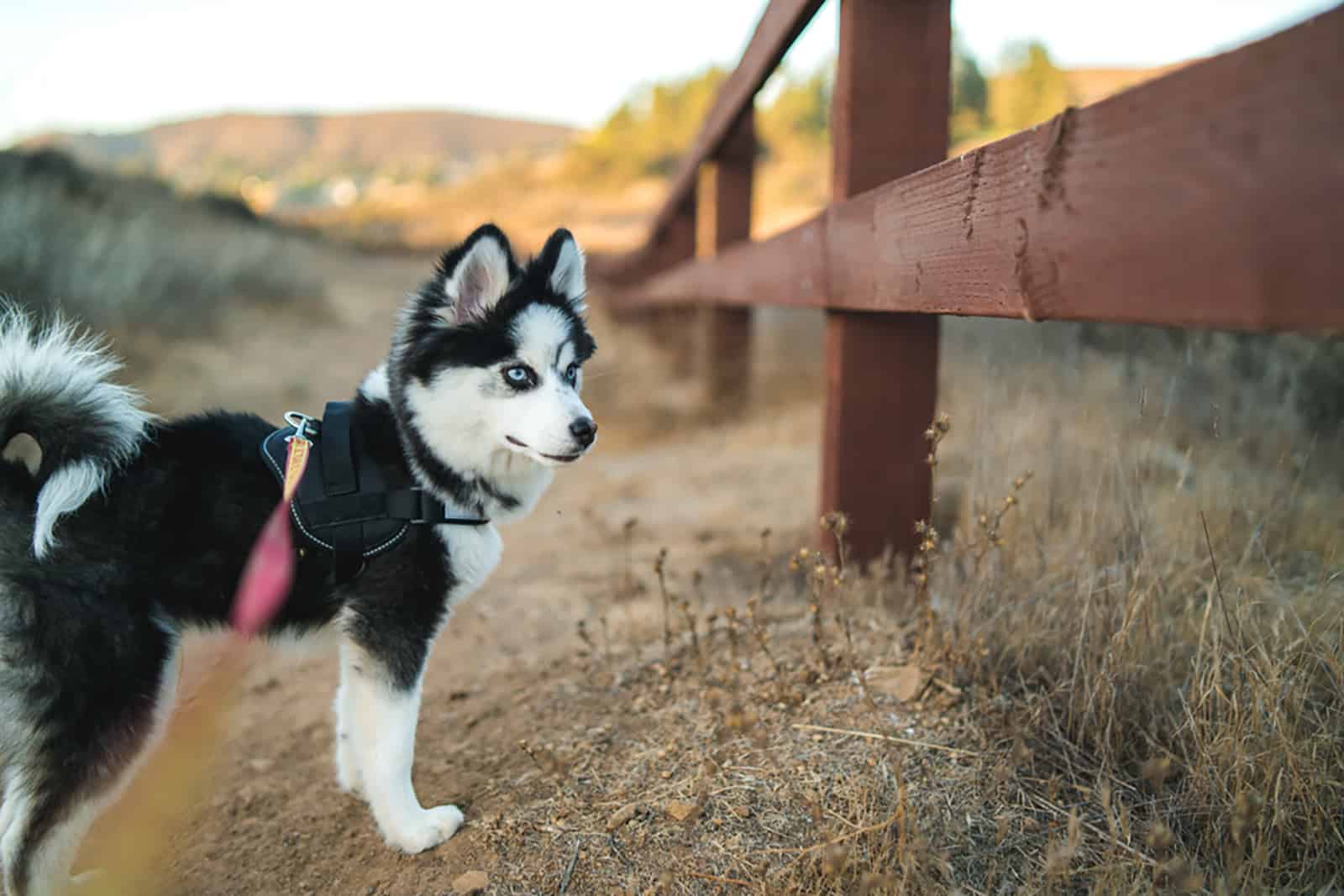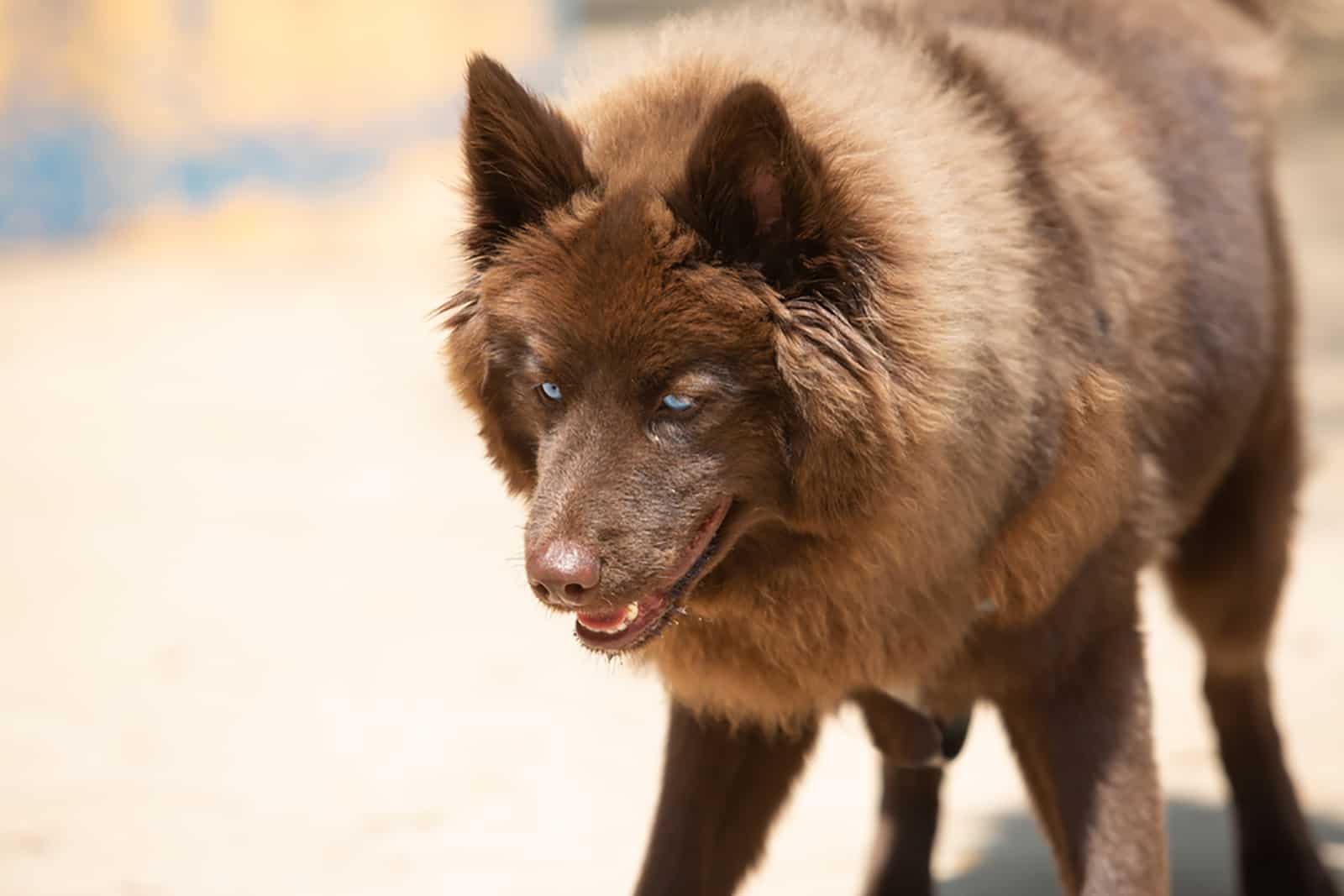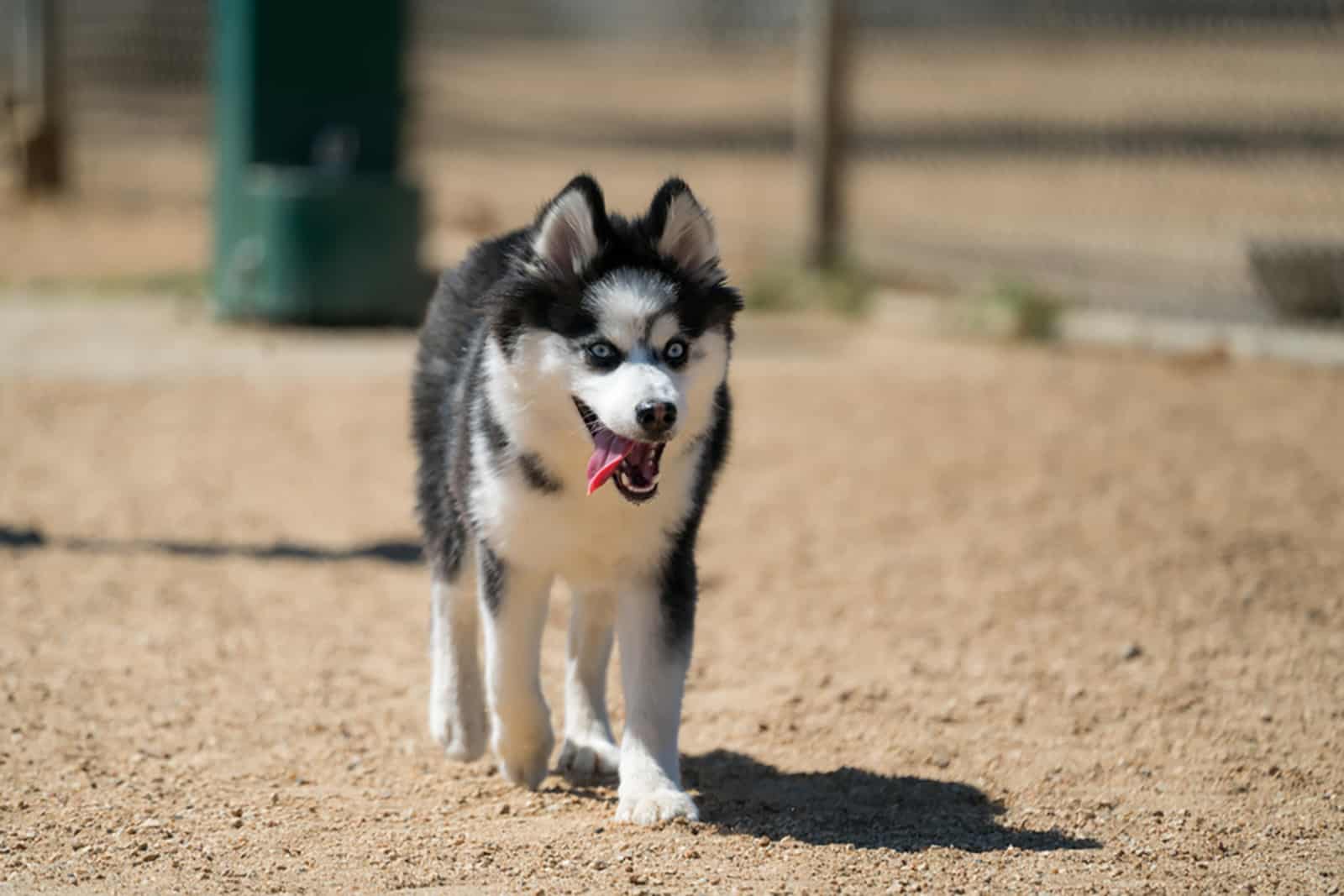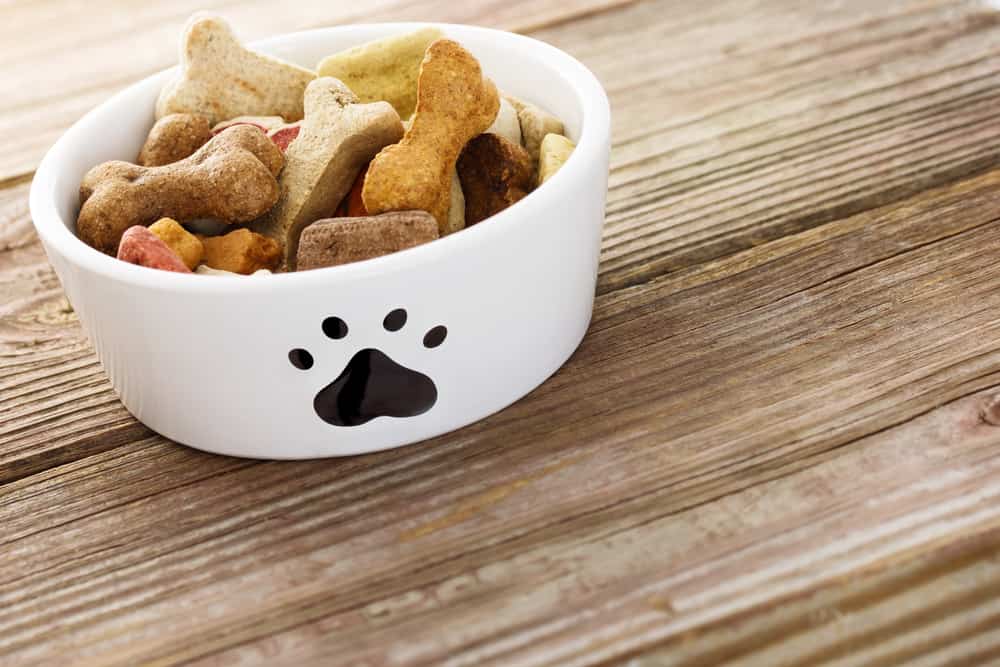The Pomsky is one of those really special dog breeds that everyone seems to love. The unique mixture of the Siberian Husky and the Pomeranian usually results in a dog resembling a mini version of the Husky.
However, their actual adult size is a bit more complicated than that, which is why we’ve decided to provide you with a Pomsky growth chart that will shed some more light on these adorable little balls of fur.
The Pomsky is one of the newest dog breeds out there, with the first breeding thought to have occurred sometime in 2009. Their appearance often makes people mistake them for mini Huskies but this is actually an entirely different breed.
When it comes to crossbreeding two completely different dog breeds, the results can be highly unpredictable. With Bulldogs, for instance, there are unique health risks that are inherent to the breed.
Luckily, there aren’t many serious medical risks involved in breeding Pomskies, but there can be some complications.
The size difference between Siberian Huskies and Pomeranians, for example, means that breeders will mostly use artificial inseminations instead of traditional methods.
Pomsky Growth Chart

The fact that Pomskies are relatively new, combined with the big differences in their parent breeds, means a lot of people are confused about their size.
If you’re looking to get a Pomsky puppy for yourself, you might feel like you’re in the dark regarding what to expect size-wise.
So, how big do Pomskies get?
Adult Pomskies usually grow to be anywhere between 13 and 24 inches tall (33 to 61 cm) and weigh around 20 to 30 pounds (14 to 27 kg).
Those are the average parameters, assuming that standard-sized dogs were used in the breeding process. However, if larger dogs were used, the resulting Pomsky dogs could end up being both taller and heavier.
We’ll talk about these different variations in more detail later in the article.
So, the question of how big they get is a bit more complex, which is why we have decided to answer it with a handy, easy-to-use,
Pomsky growth chart that you can use as a guideline to track your pup’s development.
In addition, we will also provide you with lots of extra information about this Pomeranian-Husky mix and its size so that you can learn everything you need to know before bringing a fluffy new member into your family.
Right, let’s take a look at their weight chart sorted by age.
Pomsky Weight Chart By Age
| Age | Average Weight |
|---|---|
| 1 week | 7.5 lbs |
| 5 weeks | 9.6 lbs. |
| 2 months | 12.7 lbs. |
| 3 months | 16 lbs. |
| 4 months | 20.6 lbs. |
| 5 months | 25.5 lbs. |
| 6 months | 30 lbs. |
| 7 months | 35.2 lbs. |
| 8 months | 39.1 lbs. |
| 9 months | 42.9 lbs |
| 10 months | 46.2 lbs |
| 11 months | 48.3 lbs. |
| 12 months | 50 lbs. |
| 18 months | 55 lbs. |
Different Sizes Of Pomsky

The huge difference in size between their parents will naturally result in Pomskies themselves having a lot of variation in their size. They don’t have distinct size classes like, for example, Poodles, but they have a very wide range of height and weight.
Siberian Huskies are classed as a medium breed, and Pomeranians are considered toy dogs, so the majority of their Pomsky offspring will fall somewhere on the small dog breed spectrum. However, that is not always the case.
There are occurrences of Pomskies being a medium-sized breed if the Husky genes prevail, but it can go the other way too – they can end up being a small dog, toy dog, or even a teacup.
Speaking of teacup Pomskies, we need to talk about some of the concerns associated with them.
Are Teacup Pomskies Healthy?
Teacup dogs are clearly the cutest thing ever. They’re like little plush toys that you can carry around in your bag.
But there aren’t a lot of breeds that are naturally so tiny. In fact, most of them are bred artificially, and sometimes the breeding practices involved aren’t the most ethical or beneficial for the puppies.
Pomskies are one of those breeds that have to go through a lot of guided breeding to get a teacup-sized one.
In order to get such small Pomsky dogs, breeders will often pick out the smallest pups from a litter and combine them with other runts, occasionally even underfeeding them to make sure they stay as small as possible.
That will, of course, have negative consequences on the puppies’ health and may sentence them to a lifetime of struggling with diseases. That’s why it’s best to steer clear of teacup Pomskies and go for the more standard-sized variations.
How Old Are Pomskies When They Stop Growing?

The exact timing of physical maturity will depend on the particular Pomsky’s size category, but it generally happens between the ages of 10 and 12 months.
At this age, they reach their full-grown height and weight, and only experience slight changes in their bodies from this point onwards. They can continue to develop and tone their muscle tissue, but they will stay about the same size.
It’s important to note that the larger the dog, the longer it will take for it to reach full physical maturity. So, if your Pomsky is a small dog, a toy dog, or a teacup, it will most likely stop growing around the 10-month mark.
However, medium-sized dogs will take approximately a year to develop completely, which is in line with their Siberian Husky heritage.
Most large breed dogs, like Retrievers or German Shepherds, take a longer time to reach full-grown status, and this is sometimes reflected in Pomskies that are bigger than the standard size.
Whichever size they are, there are some common development traits that every Pomsky experiences during its puppyhood. So, let’s go from the very beginning, through the different stages of their early age, and see the changes in their growth.
From Birth Until 2 Weeks
In the very first stage of their life, Pomskies are helpless little creatures, completely reliant on their mother to provide them with everything they need to grow and develop.
Their eyes and ears aren’t yet open, so they are not aware of their surroundings, and they spend most of their time sleeping. Puppy weight in this period can go up to around 6–8 pounds.
2 Weeks To 3 Months
This is a very important period in a Pomsky puppy’s lifespan, as they are introduced to a lot of new stuff. After a few weeks, their eyes and ears will open, and they will slowly start exploring the world around them.
They will start moving around and barking more as they get acclimated and used to socialization. Their teeth will start breaking out, which means you can slowly start weaning them off milk and introduce some solid puppy food to their diet.
By the end of this development stage, they will have doubled in weight.
3 Months To 6 Months
At this stage, Pomskies are old enough to show some character and personality but are still very malleable. This makes it the perfect time to train them and teach them tricks.
Puppy growth continues rapidly during this stage and, as we mentioned previously, this is the period in which they will grow to about half of their adult weight, so you can already get an idea of how big they are going to get.
6 Months To 1 Year
During this time, Pomskies will start approaching their adult height. In fact, some of them will be as tall as they are going to get by the time their first birthday comes around.
They can still continue to add weight and muscle, but their appearance will be pretty much fully formed.
Another important event that can happen at this stage of their life is sterilization. If you plan on spaying or neutering your
Pomsky, this is usually the time to do it.
Older Than 1 Year
The majority of Pomskies are considered fully grown at this age. All of their physical features are fleshed out and developed completely, so this is the point where you can consider their height and weight to be final.
If you’ve been careful throughout their development and kept track of their growth, your Pomsky should be a healthy boy or girl at this time, with their size firmly within the desired parameters.
They will also be fully formed in terms of personality and habits. Everything you’ve been teaching them during their puppyhood will be their nature by now.
What Affects Pomsky Size?

Previously in the article, we touched on the fact that the size of the Pomskies’ parents has a big influence in determining how big they will get. While that is probably the most important factor, it’s not the only one.
Other things you need to consider to get a full picture, are the dog’s generation, diet, and exercise. So, let’s go through each of these individually and see how they affect the size of a Pomsky dog.
Parent Size
Pomskies always turn out to be in between the sizes of their Siberian Husky and Pomeranian parents, usually right down the middle.
Therefore, knowing the height and weight parameters of those breeds can give you a good idea of what to expect from a Pomsky. For that reason, we’ve created special size charts for both Huskies and Poms.
Siberian Husky Size Chart
| Age | 3 months | 6 months | 1 year | Fully grown |
|---|---|---|---|---|
| Height | 10–12 inches | 14–16 inches | 20–24 inches | 20–24 inches |
| Weight | 18–30 lbs. | 26–43 lbs. | 34–57 lbs. | 35–60 lbs. |
Pomeranian Size Chart
| Age | 3 months | 6 months | 1 year | Fully grown |
|---|---|---|---|---|
| Height | 4–6 inches | 6–10 inches | 8–11 inches | 8–11 inches |
| Weight | 1–3 lbs. | 2–5 lbs. | 3–7 lbs. | 3–7 lbs. |
What Generation Is My Pomsky?
Breeding a Siberian Husky with a Pomeranian is not the only way to get a Pomsky. You can also breed two Pomsky dogs or crossbreed one with a parent breed, such as a Siberian Husky or a Pomeranian.
This means that there are distinct generations of Pomskies, who will have different genetics and grow up to be many different sizes and weights.
Here are the different breeding generations:
F1 Generation
The F1 generation is a class that includes puppies born from breeding a purebred Siberian Husky with a purebred Pomeranian.
This is the first generation of puppies, the “original” Pomskies that will generally fall within the medium breed size definitions.
F1B Generation
When you breed an F1 generation Pomsky with either a purebred Siberian Husky or a purebred Pom, you get an F1B generation Pomsky. Depending on which of the parent breeds was used, the resulting puppies will take on different characteristics.
This, of course, includes size, so it’s logical to expect that a puppy born from Pomsky and Husky parents will generally be larger than a standard Pomsky.
Likewise, a Pomsky bred with a Pomeranian will give birth to puppies on the smaller side of the spectrum. This is usually how teacup Pomskies are created.
F2 Generation
Continuing with the same pattern, when two F1 generation Pomskies are bred with each other, their offspring will be categorized as the F2 generation.
From this point onwards, Pomsky’s adult size becomes increasingly more difficult to predict accurately because of the multi-generational genetic factors at play.
F2B Generation
Going a little further down the line, we have F2B generation Pomsky dogs. These are the result of breeding an F2 generation dog with an original parent breed, i.e., a Siberian Husky or a Pomeranian.
F3 Generation And Beyond
The F3 generation is where the genetics get very diluted and even more complex. Pomskies that belong in this category are born from breeding two F2 generation dogs.
By continuing with this pattern of breeding across multiple generations, you can breed Pomsky dogs that are labeled as F4 generation, F5 generation, etc.
However, bear in mind that a higher generation number does not mean that the dogs will be smaller. F4 will not always be bigger than F5 – in fact, sometimes the puppies will grow up to be larger than their parents.
This happens because the biggest factor is still the size of the original parent breeds, even though they might be great-grandparents at this stage.
The higher number of generations simply means that the genes are slightly more diluted, so they might not be as dominant.
Diet

Nutrition will play a big role in determining how big a Pomsky gets. In order to achieve a healthy height and weight, these boys and girls need a balanced diet of high-quality kibble and even the occasional supplements to round things out.
Like with any dog, it’s important to know their exact nutritional needs before tailoring a specialized meal plan for them.
You need to know what nutrients they need, what foods they should avoid, and how much dog food they should take in on a daily basis.
This will not only help them grow and develop in the right way but means they will also stay fit and healthy.
Check out the Pomeranian feeding chart to find more useful information.
What Is A Healthy Weight For A Pomsky?
Pomskies usually reach half of their adult weight by the time they are 3.5–5 months old. So, if you weigh them when they’re at that age and multiply it by two, you should get a good approximation of their weight when they’re fully grown.
However, there is a formula that can help you predict their adult weight at an even earlier age. If you know your pup’s exact weight and its age in weeks, you can use this formula to calculate their potential weight:
Divide their current weight by their current age in weeks, then multiply it by 52, which is the total number of weeks in one full year.
This weight calculator might not be pinpoint precise, but it’s a decent guide for what to expect in an adult Pomsky, and it can help you make sure your dog is keeping a healthy weight.
Exercise
Physical activity is always closely tied to nutrition when it comes to reaching and maintaining a healthy weight in dogs.
Pomskies are very active dogs, and they need regular stimulation. Whether it’s walks, agility exercises, or playing fetch – they need at least an hour of activity every day.
The bigger they get, the more movement they will need. So, make sure that you adjust their level of activity as they grow up, and if you happen to have a larger than standard Pomsky, feel free to spend even a couple of hours each day actively playing with them.
It probably goes without saying, but exercise is especially important if you notice that your dog exceeds the desired weight parameters from the Pomsky growth chart.
Overweight and obese dogs need to be put on a more intense exercise regime, as well as a stricter diet.
Does Sterilizing A Pomsky Affect Its Growth?
Sterilization is the surgical procedure of removing a dog’s reproductive organs to prevent unwanted pregnancies. The procedure is generally called spaying when it comes to female dogs and neutering in males.
But does it have an impact on Pomsky’s height and weight?
It actually does. Growth hormones and reproductive hormones work together in the development of a dog’s body, especially when it comes to growing muscle and strengthening bones.
If a dog is neutered or spayed before they reach sexual maturity, chances are it will grow to be above average in size.
The recommended age for sterilization of Pomskies is generally between 6 and 9 months of age, but it’s always a safe bet to check with your vet and get their professional opinion..
Other than stopping undesired pregnancies, sterilization also has other benefits, such as lowering the risk of cancer (ovarian in females and testicular in males) and toning down aggressive behavior. Learn how to socialize an aggressive dog on this link.
Why Do I Need A Pomsky Growth Chart?

Every dog owner wants their pet to be as healthy and happy as possible. One of the biggest factors in dog health is their weight, so it’s vital to make sure it stays within a healthy range.
With a dog breed as unique as Pomsky, it can be unclear what exactly constitutes a healthy weight. They are a mixed breed, and like many other designer dogs, they have a complex genetic background.
This inevitably results in a variety of different sizes, which can often confuse dog lovers and leave them unsure of what to expect.
That’s why having a simple Pomsky growth chart that you can reference whenever you need is a no-brainer.
At every point of your Pomsky’s development, you can stop and check whether they’re on the right track and make a correction if they’re not.
You can also use it to calculate and predict their adult weight while they’re still in their puppyhood so that you know what to expect in the future and prepare yourself on time.
But there are even more benefits to it than that. Knowing how big your full-grown Pomsky will be can help you plan things out.
You will know how much space they will need to move around, how much food they will be eating, how big of a kennel they should have, etc.
Conclusion
A Pomsky growth chart is a must-have for any Pomsky owner. It can clear up any concerns or doubts you might have about your pup’s size and development in general.
Hopefully, this article has provided a lot of extra information that you will find useful in providing your Pomsky with the best possible conditions for healthy growth and development.
And if you are not yet a Pomsky owner and are thinking of becoming one, we hope it can guide you and help you know what to expect.
Just remember, when getting a new puppy, always make the effort to learn everything you can about the Pomsky breeders available to you.
Highly reputable breeders will have puppies with the best genetic background and with minimal risk of any future health conditions.
Read Next:
• Pomsky Lifespan: A Guide To Taking Care Of Your Huskeranian
• Rough Collie Growth Chart: How Big Does Lassie Get?













